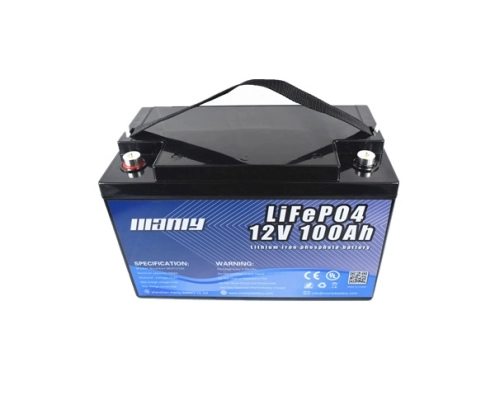How Long Will a 100Ah Battery Last?
Table of Contents
- How Long Will a 100Ah Battery Last?
- Understanding Battery Capacity
- Types of 100Ah Batteries
- Detailed Method to Calculate How Long a Battery Will Last
- How to Calculate Battery Run Time: A Practical Guide
- How Long Does 100Ah Battery Last in a Golf Cart
- How Long Will 4 Parallel 12v 100Ah Lithium Batteries Last
- Conclusion
- Learn More About Battery
Types of 100Ah Batteries
When it comes to 100Ah batteries, there are three main types: 100ah lithium ion battery, 100ah LiFePO4 battery, and 100ah lead acid battery. Each of these batteries has unique characteristics, and they are used in different applications based on their strengths and weaknesses. Understanding these differences is crucial for selecting the right battery for your needs.
1. Overview of Different Types
100Ah Lithium Ion Battery: Lithium ion batteries are well-known for their high energy density and long life. They are commonly used in portable electronics, electric vehicles, and renewable energy systems. These batteries are lightweight and can store a large amount of energy in a small space. A typical 100Ah lithium ion battery can provide a reliable power source for various applications, making it a popular choice.
100Ah LiFePO4 Battery: LiFePO4, or lithium iron phosphate, batteries are a type of lithium ion battery that offers enhanced safety and longer cycle life. These batteries are particularly known for their stability and resistance to overheating. They are often used in applications where safety is a top priority, such as in electric vehicles, solar energy systems, and backup power supplies. A 100Ah LiFePO4 battery can withstand more charge and discharge cycles compared to other lithium ion batteries.
100Ah Lead Acid Battery: Lead acid batteries are one of the oldest types of rechargeable batteries. They are heavier and bulkier compared to lithium ion batteries, but they are also more affordable. Lead acid batteries are commonly used in automotive applications, uninterruptible power supplies (UPS), and backup power systems. While they have a shorter cycle life and lower energy density, they are reliable and cost-effective for many uses.
2. Comparison Between Them and Their Specific Applications
Energy Density and Weight:
- 100Ah Lithium Ion Battery: These batteries have a high energy density, which means they can store more energy per unit of weight. This makes them ideal for portable devices and electric vehicles where weight is a critical factor.
- 100Ah LiFePO4 Battery: LiFePO4 batteries also have a high energy density but are slightly heavier than standard lithium ion batteries. However, their enhanced safety and long cycle life make them suitable for stationary applications like solar energy storage and backup power.
- 100Ah Lead Acid Battery: Lead acid batteries have a lower energy density, making them heavier and bulkier. They are not suitable for applications where weight is a concern, but their affordability makes them a good choice for stationary and less weight-sensitive uses.
Cycle Life:
- 100Ah Lithium Ion Battery: Typically, these batteries can endure between 500 to 1000 charge cycles. They are well-suited for applications that require frequent cycling, such as electric vehicles and portable electronics.
- 100Ah LiFePO4 Battery: LiFePO4 batteries excel in cycle life, with a range of 1000 to 2000 cycles. This makes them perfect for long-term use in renewable energy systems and electric vehicles.
- 100Ah Lead Acid Battery: These batteries have a shorter cycle life, usually around 300 to 500 cycles. They are better suited for applications where the battery is not cycled frequently, such as backup power systems.
Safety:
- 100Ah Lithium Ion Battery: While generally safe, these batteries can pose risks if damaged or improperly handled, including potential fire hazards.
- 100Ah LiFePO4 Battery: These batteries are among the safest lithium ion batteries, with a much lower risk of overheating and fire. They are ideal for applications where safety is paramount.
- 100Ah Lead Acid Battery: Lead acid batteries are relatively safe but can produce hydrogen gas during charging, which requires proper ventilation to avoid explosions.
Cost:
- 100Ah Lithium Ion Battery: These batteries are more expensive due to their advanced technology and high energy density. The higher upfront cost is often justified by their performance and longevity.
- 100Ah LiFePO4 Battery: LiFePO4 batteries are also costly, but their long cycle life and safety features make them a worthwhile investment for many users.
- 100Ah Lead Acid Battery: Lead acid batteries are the most affordable option. Their lower cost makes them accessible for a wide range of applications, despite their lower performance metrics.
In conclusion, the choice between a 100ah lithium ion battery, 100ah LiFePO4 battery, and 100ah lead acid battery depends on your specific needs and priorities. If you need a lightweight battery with high energy density, a lithium ion battery is a good choice. For maximum safety and longevity, a LiFePO4 battery is ideal. For cost-effective solutions with less frequent cycling, lead acid batteries are the way to go.
Detailed Method to Calculate How Long a Battery Will Last
Understanding how long a battery will last is important for planning and reliability. The run time of a battery is determined by several factors, including its capacity, the load connected to it, and the condition of the battery. Here, we’ll break down the process to calculate the run time for a 100ah battery.
First, let’s understand battery capacity. Battery capacity is measured in amp hours (Ah). A 100ah battery means it can provide 100 amps for one hour, or 10 amps for 10 hours. To calculate how long a battery will last, you use the formula:
Battery Run Time (hours)=Battery Capacity (Ah)Load (amps)
For example, if you have a 100Ah battery and you connect a 10-amp load, the battery would last:
This simple formula helps you estimate the run time under different loads.
1. Using an amp hour calculator to Determine Run Time
An amp hour calculator is a useful tool that simplifies these calculations. By inputting the battery’s capacity and the load, the calculator gives you an immediate estimate of how long the battery will last. This is especially helpful for those who might find manual calculations challenging.
For instance, if you have a 100ah lithium battery and you connect it to a device that uses 5 amps, the calculator will show:
This means the 100ah battery will last for 20 hours before needing a recharge.
Example Calculations for Common Devices
Let’s go through some common examples to see how this works in real life.
Example 1: Running a TV
- Assume the TV uses 2 amps.
- With a 100ah lithium battery:
So, the TV can run for 50 hours.
Example 2: Powering a Laptop
- A laptop might use around 5 amps.
- With a 100ah lithium battery:
The laptop can run for 20 hours.
Example 3: Running an RV’s Lights
- RV lights could use 1 amp.
- With a 100ah lithium battery:
This means the lights can stay on for 100 hours.
2. Factors Affecting Battery Life
While these calculations give you a basic idea, several factors can affect the actual run time of a 100ah battery:
- Battery Condition: New batteries perform better than old ones. Over time, the capacity of a battery decreases. A 100ah lithium battery in good condition might give you close to 100Ah, but an older one might not.
- Discharge Rate: Batteries have different discharge rates. For instance, a 100ah LiFePO4 battery can typically discharge at higher rates compared to a lead acid battery without losing efficiency. This means a 100ah LiFePO4 battery might provide more consistent run time across different loads.
- Temperature: Extreme temperatures can affect battery performance. At very low temperatures, the battery’s efficiency drops, reducing the run time. For example, a 100ah lithium battery might only last half as long at -10°C compared to room temperature.
- Self-Discharge: Over time, batteries lose charge even when not in use. Lithium batteries have a low self-discharge rate, often around 2% per month. In contrast, lead acid batteries can lose up to 4% per week. This affects how long the battery can hold its charge when stored.
- Load Characteristics: Some devices draw more power intermittently. A device with a higher starting current might reduce the battery’s run time faster than a device with a steady load.
Understanding these factors helps in better planning and managing battery life. For instance, using an amp hour calculator can give you an estimate, but considering the battery’s condition, temperature, and discharge rate will give you a more accurate idea of the battery’s performance in real-world conditions.
In conclusion, calculating the run time of a 100ah battery involves knowing the battery’s capacity and the load it needs to support. Tools like an amp hour calculator make this process easier, but remember to consider additional factors like battery condition, temperature, and discharge rate for a more precise estimate.
How to Calculate Battery Run Time: A Practical Guide
When you need to figure out how long a 100Ah battery will last, there are several steps and factors to consider. This guide will walk you through the process using simple terms and examples.
(For a precise and efficient calculation of battery runtime, the Lead Acid, Lithium & LiFePO4 Battery Runtime Calculator offers accurate and user-friendly results.)
1. Understanding Battery Capacity in Watt-Hours
The first thing to know is how to convert the battery capacity from amp-hours (Ah) to watt-hours (Wh). Watt-hours are a better measure because they show the energy consumption directly.
To convert amp-hours to watt-hours, multiply the amp-hours by the battery voltage. Most deep-cycle batteries work at 12 volts. For a 100Ah battery, the calculation is:
Wh=Ah×Voltage
So,
Wh=100×12=1200 watt-hours
This means the battery can provide 1200 watts for one hour.
2. Considering Depth of Discharge (DoD)
Next, we need to consider the Depth of Discharge (DoD), which is the percentage of the battery that can be safely used. For lead-acid batteries, the DoD is usually 50%. For LiFePO4 batteries, it’s typically 100%.
For a lead-acid battery:
Available Capacity=Wh×DoD
=1200×0.50=600 watt-hours
For a LiFePO4 battery:
Available Capacity=1200×1.00=1200 watt-hours
3. Accounting for Inverter Efficiency
Batteries provide DC power, but most devices use AC power, so an inverter is used to convert DC to AC. Inverters are not 100% efficient; they usually have an efficiency rating (ER) of about 95%.
For a lead-acid battery:
Net Capacity=Available Capacity×ER
=600×0.95=570 watt-hours
For a LiFePO4 battery:
Net Capacity=1200×0.95=1140 watt-hours
4. Calculating Run Time
Now that we have the net capacity, we can calculate the run time. You need to know the total power consumption of the devices you’re using, measured in watts.
For example, if you’re using a 50W lamp and a 50W speaker, the total load is:
Total Load=50W+50W=100W
The run time is the net capacity divided by the total load:
For a lead-acid battery:
For a LiFePO4 battery:
5. Practical Example
Let’s put this into a real-life scenario. Imagine you have a camping trip and you bring a 100Ah LiFePO4 battery, a 50W lamp, and a 50W portable speaker.
- Convert amp-hours to watt-hours:
- Consider DoD for LiFePO4:
- Account for inverter efficiency:
- Calculate total load:
- Determine run time:
This means your battery will last approximately 11.4 hours with these two devices running simultaneously.
By understanding these steps, you can accurately determine how long your battery will last under different conditions. This method applies to various types of batteries and devices, helping you plan better for your energy needs.
How Long Does 100Ah Battery Last in a Golf Cart
Understanding how long a 100Ah battery can last in a golf cart involves several factors, including battery type, usage patterns, and environmental conditions. A standard Lifepo4 golf cart battery with a capacity of 100Ah typically offers a balance between performance and longevity, making it a popular choice among golf cart owners. However, determining the actual runtime of a 100Ah golf cart battery requires a closer look at its specifications and how it is used in different scenarios.
1. What is the Life Expectancy of Golf Cart Batteries?
The golf cart battery life expectancy is influenced by multiple variables, such as battery type, usage frequency, and maintenance practices. Generally, the life expectancy of golf cart batteries ranges from 3 to 5 years for lead-acid batteries and can extend up to 8-10 years for lithium options like Lifepo4 golf cart batteries. Proper care and regular maintenance can help maximize golf cart battery lifespan, ensuring that your investment lasts as long as possible.
2. Key Factors Influencing Golf Cart Battery Life
The golf cart battery lifespan is influenced by a combination of factors such as battery capacity, age, type, and maintenance practices. For example, batteries that are frequently deeply discharged, used in extreme temperatures, or stored improperly will experience a shorter lifespan. Ensuring that the batteries are used under optimal conditions can significantly prolong their longevity.
- Battery Capacity: The capacity, measured in amp-hours (Ah), indicates how much energy the battery can store. A 100Ah battery can theoretically supply 100 amps for one hour or 10 amps for 10 hours. However, real-world factors such as driving conditions and terrain can alter this.
- Battery Age: Over time, batteries naturally degrade. This process is accelerated by deep discharges, extreme temperatures, and poor charging habits. An aging battery will have a reduced ability to hold a charge, resulting in shorter runtime.
- Battery Type: Lithium batteries, such as Lifepo4 golf cart batteries, generally have a longer lifespan compared to traditional lead-acid batteries. They also have lower maintenance needs and better energy efficiency.
- Usage Patterns: Frequent and high-current discharges, as well as running the battery to extremely low levels, can shorten its lifespan. Golf carts used on hilly terrain or for towing purposes will put more strain on the battery.
- Environmental Conditions: High temperatures can accelerate chemical reactions inside the battery, causing faster wear. Cold temperatures can reduce the battery’s capacity, impacting performance and lifespan.
- Maintenance Practices: Regularly checking battery connections, cleaning terminals, and maintaining proper electrolyte levels (for lead-acid batteries) can prevent premature battery failure.
3. How Long Does a 100Ah Battery Last in a Golf Cart?
A 100Ah golf cart battery will typically last between 4 to 8 hours on a single charge, depending on driving conditions and usage. If the golf cart operates on flat terrain with a moderate load, you can expect the battery to last closer to 8 hours. On hilly terrain or with a heavier load, the battery’s runtime may be reduced to around 4 hours.
For instance, if a golf cart uses an average of 10 amps per hour, a fully charged 100Ah Lifepo4 golf cart battery would provide approximately 10 hours of use (100Ah ÷ 10A = 10 hours). However, it’s important to note that real-world usage varies due to factors such as speed, terrain, and the cart’s total weight.
4. When to Replace Golf Cart Batteries?
You should replace golf cart batteries when their performance noticeably declines, such as when the cart’s runtime decreases significantly or when the battery struggles to hold a charge. Physical signs such as swelling, leaking, or cracked casings are also strong indicators that the batteries are near the end of their lifespan.
Replacing golf cart batteries can be a significant investment, so it’s crucial to know when it’s time to upgrade:
- Reduced Runtime: If you notice a significant drop in the golf cart’s runtime after a full charge, this is a strong indicator that the battery capacity is decreasing.
- Slower Charging: When a battery takes significantly longer to charge than usual, it may be reaching the end of its lifespan.
- Physical Deformation: Swelling, cracking, or leakage are signs of internal damage. If you see these, it’s time to replace golf cart batteries immediately.
- Low Voltage Readings: Consistently low voltage readings after a full charge indicate that the battery can no longer hold its charge effectively.
- Frequent Need for Charging: If you find yourself charging the battery more frequently than before, it means the battery’s ability to store energy has diminished.
5. How to extend the life of golf cart batteries?
To extend the golf cart battery lifespan, it’s important to charge the batteries properly, keep them clean, and avoid deep discharges. Using a charger specifically designed for the battery type and storing the batteries in a cool, dry place will also help ensure they last as long as possible.
Taking good care of your golf cart batteries can significantly extend their lifespan:
- Regular Charging: Always recharge the batteries after each use. Avoid letting the battery drop below 20% charge as deep discharges can shorten its lifespan.
- Use the Right Charger: Use a charger specifically designed for your battery type. For Lifepo4 golf cart batteries, using a compatible charger will help maintain the battery’s performance.
- Avoid Extreme Temperatures: Store and use your batteries in temperatures between 50°F and 77°F (10°C and 25°C) to minimize wear and tear.
- Clean Battery Terminals: Corrosion on the terminals can lead to poor electrical connections. Regular cleaning with a brush and baking soda solution will ensure good conductivity.
- Check Water Levels: For lead-acid batteries, regularly check and top up the water levels with distilled water. Low water levels can damage the battery’s internal components.
How Long Will 4 Parallel 12v 100Ah Lithium Batteries Last
The runtime of 4 parallel 12v 100Ah lithium batteries depends on the total energy capacity and the power consumption of the connected devices. When configured in parallel, these batteries provide a total energy capacity of 4800 watt-hours (Wh). By dividing this capacity by the device’s power draw in watts, you can calculate the approximate runtime.
1. How Parallel Connection Increases Battery Capacity
In a parallel configuration, the capacity of the battery pack increases while the voltage remains constant. For 4 parallel 12v 100Ah lithium batteries, the total capacity is calculated as follows:
- Voltage: 12 volts (unchanged in parallel connection)
- Total Capacity: 100 Ah×4=400 Ah
The energy stored in this configuration is:
Total Energy=Voltage×Capacity=12 V×400 Ah=4800 Wh
This enhanced capacity means the batteries can deliver power for longer durations without recharging. For example:
- A device drawing 100 watts will run for approximately 48 hours:
Runtime (hours)=Total Energy (Wh) / Power Draw (W)=4800 / 100=48 hours
This principle highlights why parallel configurations are ideal for applications requiring extended runtimes.
2. 4 Parallel 12v 100Ah Lithium Batteries Runtime Calculation Chart
The following chart provides runtime estimates for devices with varying power consumption levels, assuming optimal conditions (e.g., 77°F or 25°C and 100% Depth of Discharge (DOD)):
| Device Power Consumption (W) | Runtime (Hours) |
|---|---|
| 50 | 96 |
| 100 | 48 |
| 200 | 24 |
| 500 | 9.6 |
| 1000 | 4.8 |
However, in real-world scenarios, factors like temperature and Depth of Discharge (DOD) significantly impact these runtimes. For example:
- Temperature Effects:
- Cold Weather: At lower temperatures (below 32°F or 0°C), battery efficiency may drop by up to 20-30%. This reduces the available capacity, meaning a device drawing 100W would run for approximately 33-38 hours instead of 48.
- Hot Weather: High temperatures (above 104°F or 40°C) can also degrade performance over time, though the immediate impact is less severe compared to cold conditions.
- Depth of Discharge (DOD):
- Most 12v 100Ah lithium batteries are designed for deep discharge, but manufacturers often recommend a DOD of 80% for maximum lifespan. Using only 80% of the total capacity (3840Wh instead of 4800Wh), a 100W device would run for approximately 38.4 hours.
Adjusted Runtime Calculation Chart (Considering Temperature and 80% DOD)
To better reflect real-world conditions, here’s an updated runtime chart accounting for a typical 80% DOD and moderate temperature variations:
| Device Power Consumption (W) | Runtime (Hours) (80% DOD) | Runtime (Hours) (Cold Weather – 70% Efficiency) |
|---|---|---|
| 50 | 76.8 | 67.2 |
| 100 | 38.4 | 33.6 |
| 200 | 19.2 | 16.8 |
| 500 | 7.68 | 6.72 |
| 1000 | 3.84 | 3.36 |
Explanation of Temperature and DOD Impacts
- Battery Efficiency in Cold Weather:
At low temperatures, lithium-ion batteries experience reduced chemical activity, which directly lowers their efficiency. For users in cold climates, it’s crucial to store batteries in insulated or heated compartments to maintain runtime and capacity. - DOD and Lifespan:
Frequently discharging a battery to its full capacity can shorten its lifespan. For instance:- 80% DOD ensures a longer lifecycle, typically 2000-3000 charge cycles.
- 100% DOD might reduce the lifespan to around 1500 cycles.
- Load Variability:
Higher power consumption (e.g., 500W or more) amplifies the effects of temperature and DOD on performance. In such cases, selecting a slightly oversized battery system can help mitigate runtime reductions.
By considering these factors, users can better plan for realistic runtimes and ensure optimal performance of their 12v 100Ah lithium battery systems under varying conditions.
3. Application Scenarios: Runtime for 4 Parallel 12v 100Ah Lithium Batteries
This battery configuration is suitable for various scenarios that require reliable, long-lasting energy storage:
- Solar Power Systems:
In solar setups, 4 parallel 12v 100Ah lithium batteries provide ample storage for backup power. For instance, they can support a 200W load (e.g., lights and small appliances) for 24 hours continuously. - Recreational Vehicles (RVs):
For RV enthusiasts, this setup can power a combination of appliances such as refrigerators, fans, and lights. A typical 300W load would last approximately 16 hours. - Off-Grid Applications:
For remote cabins or off-grid homes, this system ensures continuous power for essential devices like water pumps or communication equipment. - Backup Power for Critical Devices:
Hospitals or IT facilities can use these batteries to power critical systems during outages. A 500W load, for example, would run for nearly 9.6 hours.
By understanding the capacity and calculating runtime, users can optimize their 12v 100Ah lithium battery systems for specific needs.
Conclusion
In summary, understanding the run time of a 100ah battery involves more than just knowing its capacity. Factors like the connected load, battery condition, depth of discharge, and inverter efficiency all play crucial roles in determining how long your battery will last. Using an amp hour calculator and considering these variables will help you make informed decisions and ensure you get the most out of your battery. Whether you’re using a 100ah lithium battery, a 100ah LiFePO4 battery, or a 100ah lead acid battery, this knowledge will help you plan better and avoid unexpected power shortages. With these insights, you can confidently select and use the right battery for your specific needs, ensuring reliable and efficient power management.







